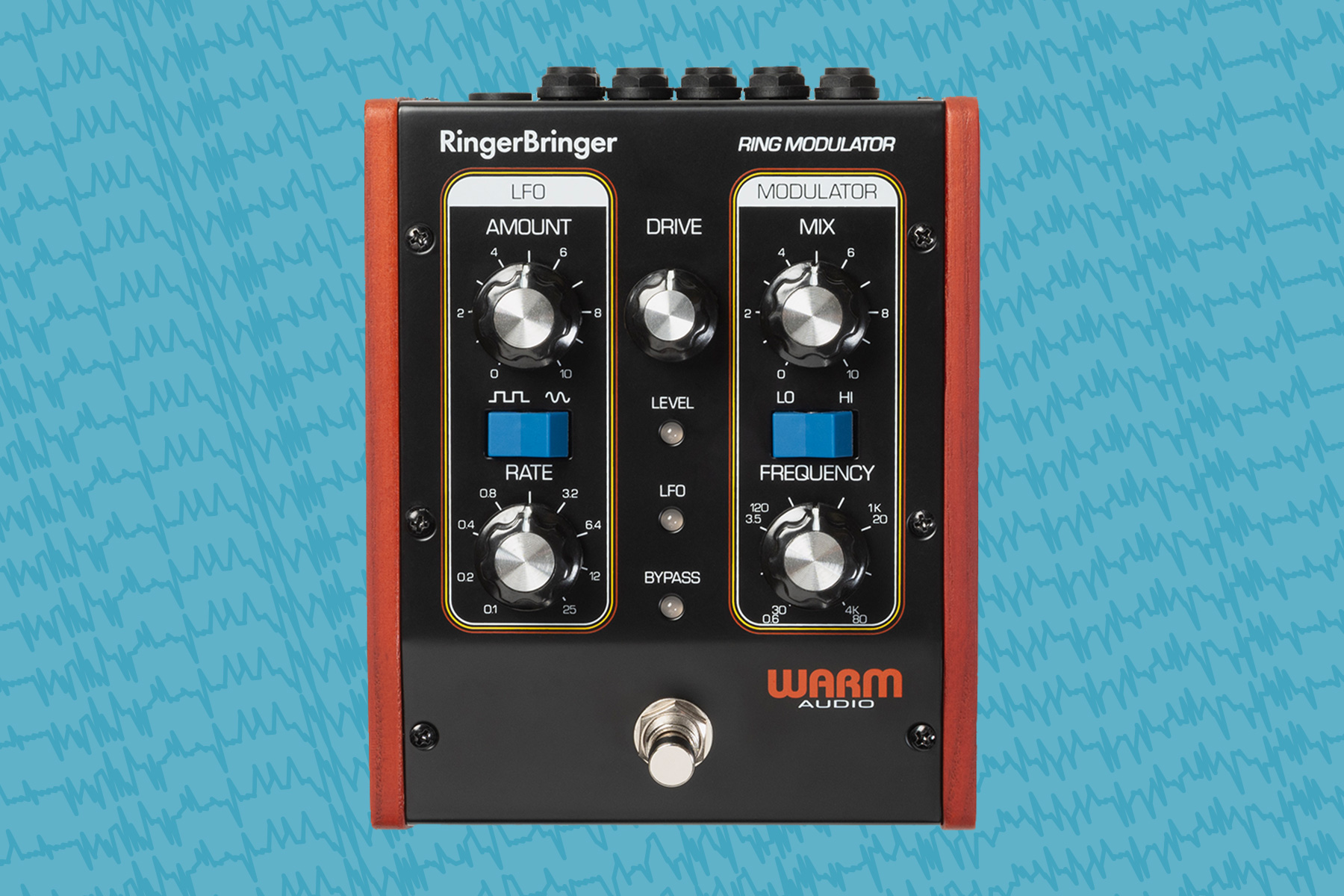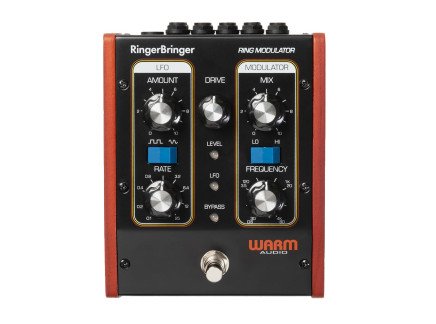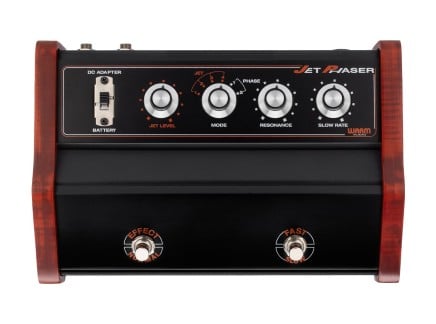Sometimes, you get what you wish for—and for a lot of boutique pedal enthusiasts and synthesizer lovers, we think that today is one of those times. We're talking about Warm Audio's new pedal RingerBringer...which brings the sound and visual aesthetic of one of the most interesting ring modulators of all time back into production. And, beyond that, its price is excellent. All you early-'00s prog and experimental rock enthusiasts rejoice—you're going to sound like the Mars Volta in no time flat.
If you're not already clued in, RingerBringer is Warm Audio's compact ode to the Moog MF-102 Ring Modulator, from the Moogerfooger series of effect pedals. We offered a detailed retrospective on the Moogerfooger series in a recent Signal article, but if you haven't checked that out yet, here's a summary. For many years (between the 1970s and c. 2000), Dr. Robert Moog, inventor who developed some of the first commercial synthesizers ever produced, didn't build "Moog"-branded synthesizers at all—the company that bore his name was under different management. During those years, his company Big Briar continued to produce other products, mostly in the form of controllers.
However, as interest in analog synthesizers strengthened over the 1990s, Moog heard the public's call—and eventually, he returned to analog synthesizer production. However, he didn't first do this by building synthesizers, per se; instead, we got the Moogerfoogers. These pedal/desktop-format devices straddle the line between innovative effect pedals and pure modular synthesizers. Each one contained a world-class analog audio processor coupled with a purpose-built modulation section. As such, each one had an uncommon amount of "life": rather than simple, set-and-forget style play, these pedals rewarded adventurous modulation through internal LFOs, envelope followers, sequencing, and more. What's more, these pedals featured extensive I/O...often providing not only I/O for the audio effect itself, but control voltage inputs for various effect parameters as well as control voltage outputs from the pedals' internal modulation sources. So, Moogerfoogers were much more that just pedals: they were a modular synthesis ecosystem, in which many pedals could be connected together to create animated, evolving, and lively sound generation and processing.
Several years ago, these modern classics were discontinued, and prices have skyrocketed on the used market. As such, musicians have clamored for Moog to reissue them. While Moog has released some truly wonderful virtual Moogerfoogers in the form of a suite of plugins, they've yet to answer the call to bring these back in hardware format. So, we expect that today's news will be warmly greeted by many musicians: while it may not look exactly the same, the Warm Audio RingerBringer offers all the features and I/O of Moog's original MF-102, with a form factor much more friendly for the typical pedalboard...and at an awesome price.
That said, let's take a look at the RingerBringer to see what it has to offer.
Warm Audio RingerBringer Overview
RingerBringer's internal circuitry and complement of controls are, in effect, identical to its original Moog inspiration. The biggest differences, from a user perspective, are that the enclosure is considerably smaller—a mere 6.5 x 5.25 x 3"...and the pedal uses a standard center negative 9V power supply (or 9V battery!), whereas the originals used the less common center positive connection. So, I'd call those both nice upgrades. The rest? True to the original...making this pedal perfect for everything from gentle tremolo to unconventional, otherworldly tones, grinding pitch sweeps, and modular experimentation. Using an all-analog signal path featuring LM13700M and TL072ADR op-amps and hand-selected MMBT3904 and DMMT3906W transistors, this pedal delivers the same clean, clear, and out-there tone of its predecessor.
The core of the RingerBringer is, of course, the ring modulator....which uses an internal sine wave oscillator as a carrier. Your external audio is multiplied by this internal sine wave, producing the iconic sounds of ring modulation. With the Frequency range set to Lo, you'll get tremolo and peculiar low-frequency shifts; when set to Hi, the carrier oscillator is set to a higher range, giving you more typical ring modulator tones—from peculiar resonances and grating dissonances to robotic atonal harmonies and beyond. You can continuously vary the carrier frequency using the Frequency knob, and you can dial in your preferred balance of dry and modulated audio using the Mix control.
The other half of the RingerBringer is the LFO, which has a normalled internal connection to the carrier oscillator's frequency. You can choose sine and square LFO shapes, allowing for smooth frequency sweeps and jarring trills. (Have you ever listened to Deloused in the Comatorium or Amputechture? Think "Eriatarka guitar intro" for the sine wave setting—think "The kiosk in my temporal lobe is shaped like Rosalyn Carter" for the square wave setting.) The rate of modulation can be continuously varied, of course, for everything from slow changes to wacked-out, violent blasts of modulation.

An often-overlooked but quite handy aspect of the Moogerfooger lineup is the center Drive section, as well. The RingerBringer, like its forebears, features an input preamp that allows you to connect everything from simple passive pickup-laden electric guitars to line level and modular audio sources. Using that front-panel Drive control, you can dial in the optimal amount of gain for your signal source...but of course, you can push it a bit harder for some pleasant breakup and distortion before your audio hits the ring mod—or, dial the mix all the way back to enjoy the drive section by itself.
That covers the front-panel controls...and those alone are certainly more than enough for diving into all many of experimental tones and textures. However, the front panel is only part of the total story: let's spin things around and see those rear-panel connections.

On the rear panel, you'll see the familiar audio in and out jacks...however, the remaining seven (count 'em, seven) jacks might bear some explanation. On the bottom right, you'll see two jacks labeled Carrier In and Carrier Out. The Carrier Out jack is an output directly from the internal sine oscillator: you can patch this into your other pedals for use as a sound source, or connect it to your modular synthesizer. The Carrier In jack can be used to override the internal oscillator within the ring mod circuit, allowing you to ring modulate the audio input with sounds other than a sine wave. Try patching in a duplicated version of your signal for a peculiar, distorted pseudo-octave effect, or patch in two complementary instruments for odd, emergent harmonies. Try patching in some complex tones for truly chaotic results.
The LFO Out jack is a direct output from the internal LFO, allowing you to use it to modulate other pedals or modular or semi-modular synthesizers. The remaining jacks are all control voltage inputs, for LFO Rate, LFO Amount (modulation depth), effect Mix, and the carrier Frequency, respectively. That's right: practically every parameter on this pedal is voltage-controllable, and every internal signal (carrier and LFO) can be sent out of the pedal.
Of course, this means that you can accomplish some novel effects with the pedal itself. For instance, what would happen if you patched the Carrier Out to the LFO Rate input, and the LFO Out to the Carrier Frequency Input? Chaotic, undulating, unpredictable frequency sweeps await. Or, what if you patched the LFO out into the Mix input? You can create sounds that smoothly alternate between ring modulated and clean textures in tandem with the LFO shape. The possibilities there alone are nearly limitless.

But! This also makes the RingerBringer an excellent addition not only to guitar pedal setups, but to modular synthesizer setups as well. If you're looking for a colorful audio processor, sound source, and modulation source to augment your desktop semi-modular gear, this is a solid contender. Need an extra LFO for your 0-Coast? Want another oscillator to send into your Strega? Looking for an effect processor that you can play with your 0-Control? RingerBringer, though it might look like an effect pedal, is truly a modular synthesis tool: and one that simply sounds excellent.
So, if you've been mourning at the skyrocketing prices of MF-102s, or if you're just ready to fall in love with the sound of a real, honest-to-goodness analog ring mod, you're in luck. It's affordable, it's compact, and it's packed full of all of the Dalek voices, ramping tremolos, and jarring, electronic harmonies you could possibly hope for.












